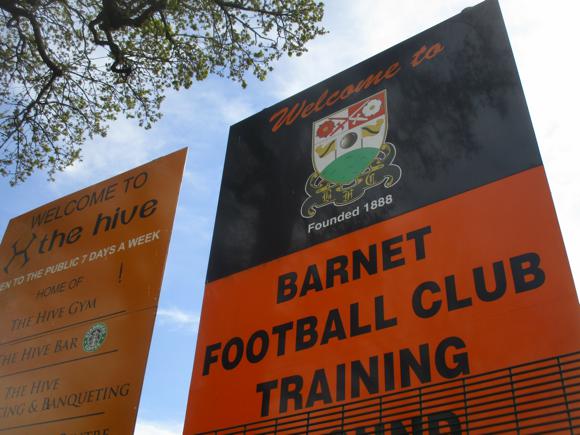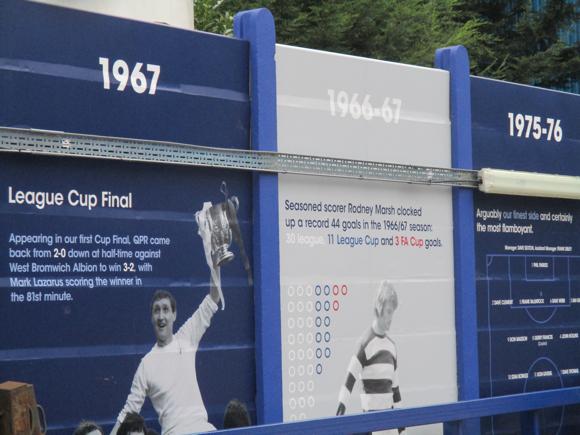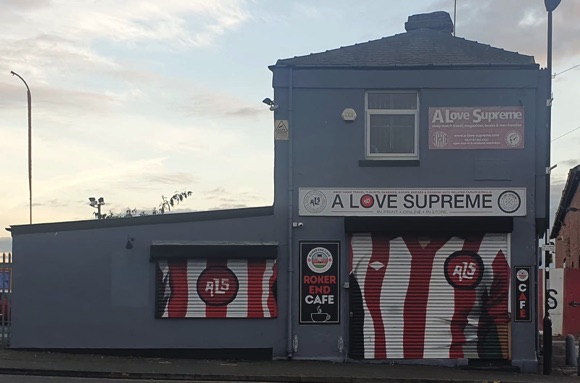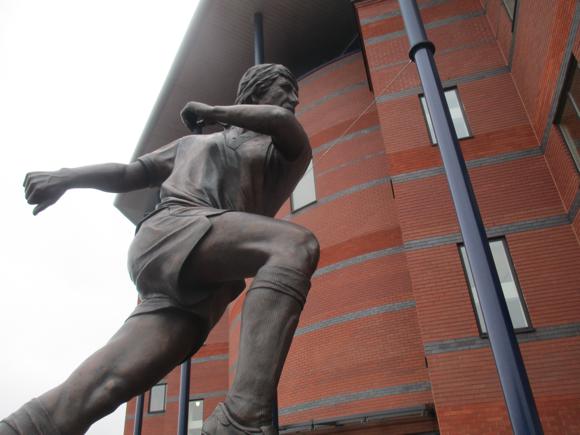The field of dreams – and the story behind it
England’s national stadium, arguably football’s most iconic arena, was opened in 1923 and rebuilt, amid controversy, eight decades later. Wembley Stadium, named after the distant north-west neighbourhood it is located in, now sports a 134-metre high arch, the world’s largest single-span roof structure, visible for many miles around.
It was not quick in coming. Originally, the old Wembley – of the famous twin towers, the inaugural ‘White Horse’ Cup Final of 1923, the Matthews Final of 1953, the World Cup Final of 1966 and no fewer than five European Cup finals – was due to be demolished after Germany beat England there in October 2000.







Following two years of bureaucratic and financial wrangling, demolition eventually began in September 2002. Spiralling costs helped cause delay after delay while cup finals were moved to the Millennium Stadium in Cardiff, and England international matches were played around the country.
A 2006 opening date was then pushed back another year. Eventually, its relandscaped Wembley Way now fronted by the imposing figure of Bobby Moore, the new Wembley hosted the FA Cup final of 2007.







Admired for its innovation – as well as the arch, the new arena featured a sliding roof – Wembley came under fire for its poor pitch, relaid several times. The surface is now 97% real, the stadium’s iconic status regained over the last decade and a half.
Welcoming back the England national side and annual League and FA Cup Finals, the 90,000-capacity new Wembley hosted the Champions League Finals of 2011 and 2013.
Between 2017 and 2019, Tottenham moved in full time while White Hart Lane was being rebuilt, having already staged European games there, often in front of crowds of 80,000-plus.



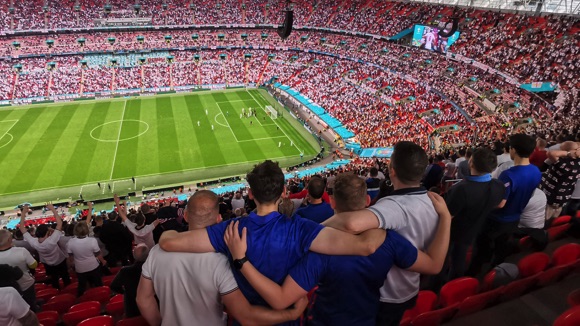
With all the logistical conundrums of Euro 2020, Wembley eventually hosted eight games the following summer. Six involved England, including one of two semi-finals here and the final, which saw disgraceful crowd scenes for hours beforehand.
Many outside the British Isles breathed a sigh of relief when the UK & Ireland opted against bidding for hosting rights for the centenary 2030 World Cup – if not, Wembley would have been called upon to do the honours.
In the end, the UK and Ireland were awarded Euro 2028, meaning Wembley stages two Euro finals within the decade. Whether it’s the World Cup or the FA Trophy, any winning captain has to scale 107 steps to collect their team’s reward, as opposed to the 39 of lore.
This changed when Leah Williamson was presented with the Women’s European Championship trophy on the pitch in 2022, to the delight of the home fans. The same rigmarole will surely be followed when Wembley hosts yet another Champions League final in 2024.







The stadium comprises three levels, with the cheapest seats (sectors numbered 501-552) around top Level 3. South and North Stands contain the dearest seats over the halfway line; the East and West Stands are behind each goal.
Since the Carabao Cup final in February 2023, nearly 900 safe-standing places are now in place at either end for major domestic fixtures – the authorities have been considering installing rail seating in all of Level 5, meaning that nearly half of Wembley, 39,000 spectators in all, will be able to stand.
Entrances are lettered A-P (no I), with J-N for the West Stand, B-F the East Stand. G-H are for the North Stand, with its Bobby Moore statue, A and P for the South Stand. Level 2 (201-252), lined with upscale bars and restaurants, is allocated to Club Wembley members (£2,394-£37,200 per annum). Level 1 (101-144) is nearest the pitch.
No fewer than 688 food and drink outlets, plus 34 bars, dot the arena. Wembley also contains 2,618 toilets, more than other building in the world.





GETTING HERE
Going to the stadium – tips and timings



There are three main stations that serve Wembley: Wembley Park Tube (Jubilee and Metropolitan lines), closest to the North Stand up Wembley Way; Wembley Central (Bakerloo line/overground rail), a 15min walk up the High Road and left to White Horse Bridge and the stadium’s south-west corner; and, the closest, Wembley Stadium station (trains from Marylebone).
For the Bakerloo line to Wembley Central from Baker Street, allow 30mins for the journey. For the quicker Metropolitan line to Wembley Park from Baker Street, allow 15mins. For the quickest, rail from Marylebone to Wembley Stadium, allow 9mins. Wembley is in zone 4.
The sat nav code for Wembley Stadium is HA9 0WS, its car parks HA9 0EG (Yellow), HA9 8DS (Red) and HA9 0HE (Pink). The Wembley Park complex of Stadium, SSE Arena and London Designer Outlet can officially accommodate 3,000 vehicles. Online booking is possible according to event but limited. Park&Ride would be a better option, at one of the outer stations on the Jubilee or Metropolitan lines.
The parking policy at nearby pubs and hotels varies, with fees of up to £25/day to leave your vehicle there.
getting in
Buying tickets – when, where, how and how much


For England internationals, tickets are available through the FA. Some tickets are set aside for the official England Supporters Travel Club, membership £75, but if you register as a member of the free-to-join My England Football, you will have priority behind the ESTC on ticket purchases before general sale.
Contact englandsupportersclub@thefa.com. Club Wembley members, who pay several thousand pounds a year for their exclusive seat, must join the ESTC or ESC separately.
If any tickets are still available in the run-up to the game and/or on match day, the windows are at the top of the Olympic steps by the Stadium Store, behind the North Stand.
Typical prices for a full international begin at £30 for the upper East End, £40 for the upper West End, and £50-£65 in the main stands. There are discounts of £10 in each category for seniors, students and under-16s.
Wembley staff cannot assist with ticket information concerning non-England internationals, play-offs, finals etc. Check with the participating FAs and clubs. The Wembley information number is (UK only) 0800 093 0824.
what to buy
Shirts, kits, merchandise and gifts


The Stadium Store (daily 11am-5pm, match nights vary) is by the East Ticket Office on Level B1 of the North Stand, accessed from the top of the Olympic steps behind the Bobby Moore statue.
Stocking mainly England gear, including the current second kit of dark blue with red side panels and retro shirts from major finals, it also offers England Subbuteo games and 3D puzzles of the stadium.
tours & museum
Explore the stadium inside and out






Entertaining stadium tours (£25 online, £18 seniors and 4-18s, daily 10am to 3-5pm according to season) begin, inevitably, with football’s most famous crossbar. The one struck by Geoff Hurst to score England’s third goal in the World Cup final hangs above the reception area – though, sadly, the life-size if not lifelike statue of hapless German goalie Hans Tilkowski is now in mothballs. Models of the original stadium with its Twin Towers and the still gleaming Jules Rimet trophy are also displayed, along with a Geoff Hurst shirt.
This is the museum part at the start of the tour, which you take at your own pace, having picked up a hand-held multimedia guide in six languages, including sign. Visitors are given 15mins to stroll around the ’66-centric display, ample time.
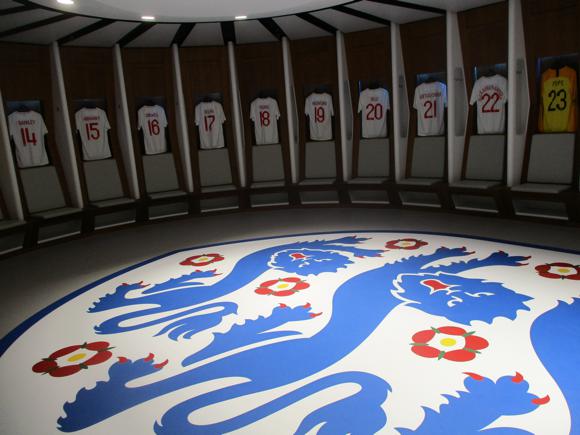






An actual guide awaits in person after you walk though The Lioness bar. You can follow your device or, way better, listen to the lively did-you-know? spiel as you’re taken round the arena. If it’s Matthew, he quizzes visitors with posers such as why does Wembley have four dressing rooms and where did they find the lost Olympic flag from 1948?
Stats are delivered in fun-like fashion without drowning you in dizzying numbers – the new Wembley is 2.5 times the size of the original one, for example. A horseshoe shape for the dressing room, the England one, was introduced by Gareth Southgate, as was the media area alongside.
After an entertaining 75 minutes or so, you can buy photos of yourself lifting the FA Cup. The tour starts and ends by the main reception just behind the Bobby Moore statue. Note that for the summer of 2024, some tours include a visit to the centre circle, giving the visitor a panoramic view of the arena as players see it.
Where to Drink
Pre-match beers for fans and casual visitors









The main clutch of pubs can be found near Wembley Park Tube, on a busy triangle of businesses on Wembley Park Drive just past Wealdstone Brook. Next to each other are the Stadium Sports Bar at No.125, the former First Class Sports Bar with its many screens and signed memorabilia, and the Wembley Tavern, another match-watching spot at No.121. Nearby at No.120, the Parish is a friendly cubbyhole of a pub with Guinness, live music and TV sport the focus, always packed for Ireland games.
It occupies the corner where Wembley Park Drive meets Olympic Way, along which the BOXPARK food court now dominates most pre-match socialising. A large main bar at street level, backdropped by a screen almost the size of Wembley, dispenses Blue Moon, Madri and Pravha on draught, among others, while street food from Argentina, the Caribbean and Malaysia beckons from surrounding outlets.
Above, a more intimate bar allows you to watch sports action from the dubious comfort of a deckchair. As if to underline the holiday-camp atmosphere, families battle over table football and ping-pong tables, and hopefully sober grown-ups engage in axe-throwing.
On the same side of Olympic Way, the Black Sheep provides artisanal brews to discerning coffee and beer drinkers.





With BOXPARK now in place, the standard chain eateries filling the London Designer Outlet right by the stadium do less trade – handy to know if the newer food court is too mobbed. Alongside, the third-floor Icons Bar at the Hilton should be open to non-guests on match days, depending on the fixture, superior burgers, Guinness and Goose Island Midway served on the terrace overlooking the stadium. Framed shots of classic Wembley moments line the interior, hence the bar name.
Upstairs, way upstairs, the ninth-floor Sky Bar 9 should be operating on a first-come, first-served basis, again depending on the fixture. Bring ample plastic for the cocktails and champagnes on offer, but there’s no finer viewpoint as the pre-match buzz rises.






For a genuine pub, it’s a stiff climb to the venerable Green Man on Dagmar Avenue, but it has an ample beer garden and its own selection of Wembley photos, both sporting (Henry Cooper and Clay, Osgood and 1970) and otherwise (Madonna, Freddie Mercury).
Just the other side of Wembley rail station, the unpretentious Corner House at 313 Harrow Road is where regulars gather for GAA, racing and football coverage over an honest pint. Opposite, The Arch is a more contemporary sports bar and Indian restaurant, with a large front terrace and guest rooms if required.











Within the stadium, the many, many options are divided between those paying top dollar to be Club Wembley members, and everyone else. The Lioness is a happy medium, done out in a riot of framed memorabilia. Here, members have their own area with stadium views while thirsty punters get stuck into the self-serve beer stations. Food leans towards gastro rather than pub grub. Also on Level Two are outlets for the Camden Town Brewery and Budweiser beer.
By contrast, the Bobby Moore Room welcomes members of the exclusive club of the same name, nearly £8,000/year granting a four-course à la carte menu and unlimited Laurent Perrier champagne.





